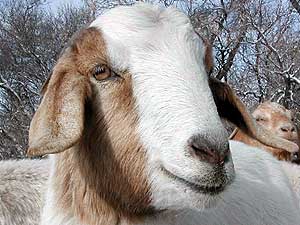|
Audio
Photos
Your Voice
|
U.S. food imports rise
February 5, 2004
 |
| A goat on the farm of Ritch Peterson. Peterson raises the animals in southwest Minnesota. He says goats are a favorite meat for several ethnic groups. (MPR Photo/Mark Steil) |
Worthington, Minn. — At worst, imported foods can drive people out of business. Farmers have complained for years about cheap dairy and meat products coming into the U.S. But imports can also create opportunity and jobs.
Take what Ritch Peterson is doing on his farm in southwest Minnesota. He raises goats.
"You got all the cartoons and stuff that have really made comedy out of them. You know eating tin cans and eating this and that" Peterson says. But they're actually a pretty finicky animal."
 | |||
When Peterson started his goat business four years ago, he knew there was a growing demand for the meat. For immigrants from Somalia and other countries, it's a traditional food. Peterson says they're often disappointed they can't find fresh meat.
"If they slaughtered all the goats that we had in this country, there'd maybe be a month's supply of meat," says Peterson. "They don't seem to be able to catch up with the number of goats to meet the demand so far." While the number of U.S. goat producers is growing, it will take years before supply catches up with demand. It means building an entire support system. Things like barns, stockyards and processing plants.
In the meantime most of the goat meat eaten in the U.S. comes from other countries. It's an example of why the U.S., with all it's agricultural wealth, still imports about ten per cent of its food each year.
Purdue University agricultural economist Phil Paarlberg says food imports are rising so quickly, they may actually surpass the amount of food the U.S. exports.
"The U.S. has been a very strong economy, relative to others," says Paarlberg. "And strong economies will pull in imports. Whether it's food imports or oil or other things."
A strong economy also attracts workers. Like Somalis with a taste for goat meat.
"They have traditional foods that they're used to and they continue to consume those," says Paarlberg.
Paarlberg says the impact of immigrants on U.S. food sales is evident in any town with a diverse population. Take Worthington in southwest Minnesota, population 11,000. A meatpacking plant and other job opportunities draw people from all over the world. Downtown Worthington has two ethnic food stores.
 | |||
L.A. Phomsatry helps manage the Ban Lao Market. Standing in front of shelves stacked high with imported canned foods, he describes some of what he sells.
"Coconut milk, we put that in every soup," he says. "Fish sauce there, that's basically salt water. And then oyster sauce, soya sauce, normal stuff like that. All Asians have this stuff."
His customers may live down the street or several counties away. He says one loyal customer drives nearly 80 miles. He says most are Asians, but not everyone. There's a white customer who comes to the store to buy crickets.
"Jumbo crickets in water," says Phomsatry. "Yea, he came and grabbed one of those. And you know he loved them. He said he went to Bangkok and he tried them before and he likes them."
Purdue University's Phil Paarlberg says U.S. consumers are eager to try new things, stoking the demand for imported food. Sometimes he says it's a brand new product, sometimes it's a familiar one with a fresh face.
"Think about the rise of the coffee shop, the Starbucks, starting what 10-15 years ago. Now there's a Starbucks it seems everywhere. Well, we're consuming coffee there. And we don't grow coffee, we import coffee," says Paarlberg.
And many other things. Vegetables, wine, chocolate. Almost $50 billion worth a year. A little spice for the land of plenty.
|
News Headlines
|
Related Subjects
|
